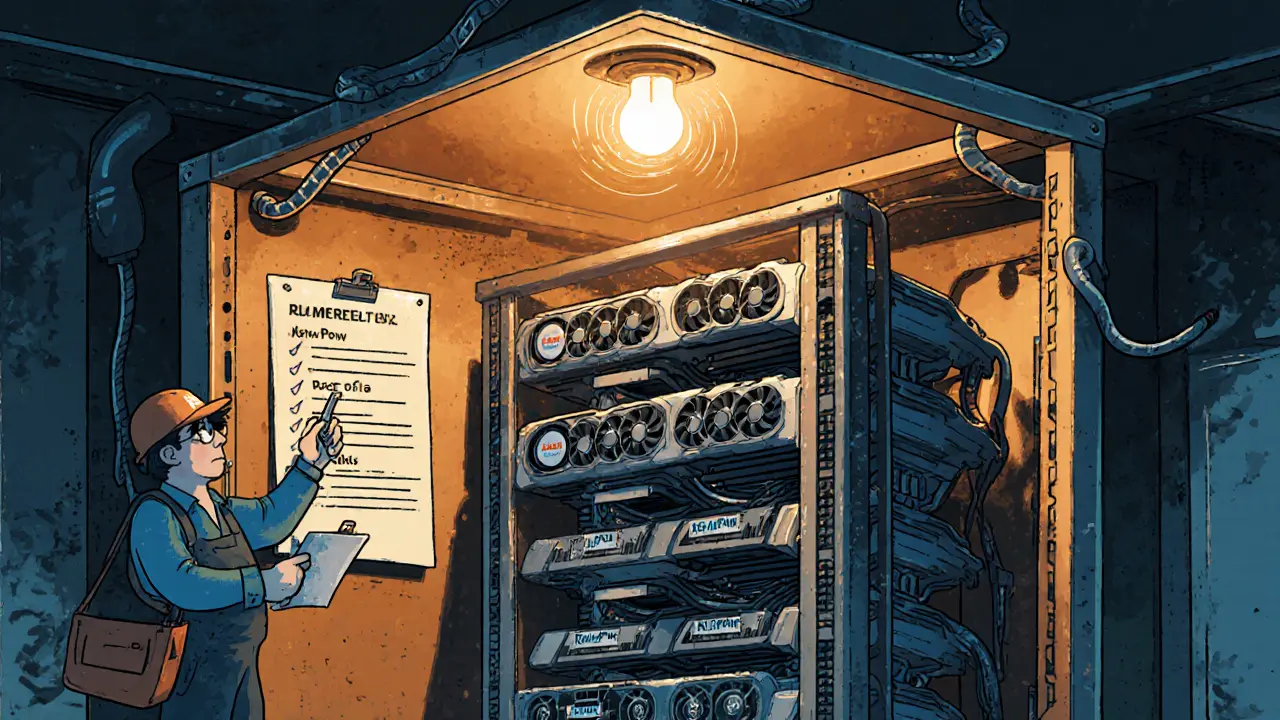
GPU Mining Profitability Calculator
Mining Profitability Result
Estimated Daily Profit:
Break-even Electricity Rate:
Estimated Monthly Profit:
ROI (if purchased today):
Top Performing GPUs (2025)
RTX 5090
KawPow
85 Mh/s
$0.66/day
RX 7900 XTX
Autolykos
78.5 Mh/s
$0.72/day
RTX 4090
KawPow
78 Mh/s
$0.50/day
GPU mining is a method of securing blockchain networks by using graphics processing units to solve cryptographic puzzles. Unlike ASICs, GPUs can switch between algorithms, letting miners chase the most lucrative coins at any moment. In 2025 the landscape has narrowed to a handful of altcoins that still reward GPU power, and success hinges on hardware choices, electricity rates, and smart software.
Key Takeaways
- Profitability now depends on electricity costs below $0.10/kWh and the right algorithm‑GPU match.
- RTX 5090 and AMD RX 7900 XTX lead the market for KawPow and Autolykos coins.
- Building a 6‑GPU rig takes 8‑12hours and costs around $4,200 for high‑end hardware.
- Management platforms like HiveOS or Minerstat cut downtime by 20% and simplify BIOS tweaks.
- Future hybrid use of GPUs for AI training can boost overall utilization when crypto profits dip.
1. Calculating GPU mining profitability
Profit equals revenue from the mined coin minus electricity and pool fees. The basic formula is:
Profit per day = (Hashrate × Coin reward × Market price) / (Network difficulty) - (Power (W) / 1000 × Electricity price $/kWh × 24) - Pool fee %
Tools like NiceHash and WhatToMine feed live difficulty and price data, but you still need to plug in your exact power draw. For example, an RTX 5090 mining KawPow at 85Mh/s consumes 360W. At $0.10/kWh electricity the power cost is $0.86/day, leaving roughly $0.14/day after a 1% pool fee-just enough to stay marginal.
2. Most Profitable Algorithms in 2025
After Ethereum’s 2022 Merge, the profitable GPU space centers on three algorithms:
- KawPow - used by Ravencoin (RVN), favors NVIDIA GPUs.
- Autolykos - powers Ergo (ERG), favors AMD GPUs.
- Cuckatoo32 - employed by Flux (FLUX), works on both brands but with lower margins.
Coins with daily trading volume over $5million and active listings on major exchanges are worth targeting, according to Digiconomist’s 2025 analysis.

3. Which GPUs Deliver the Best Returns?
Below is a snapshot of the top‑performing cards as of October2025. Numbers reflect average daily profit at $0.10/kWh electricity and a 1% pool fee.
| GPU Model | Algorithm Optimized | Hashrate (Mh/s) | Power (W) | Daily Profit $ | Price $ | Cost‑to‑Profit Ratio |
|---|---|---|---|---|---|---|
| RTX 5090 | KawPow | 85.0 | 360 | 0.66 | 1,699 | 2,575× |
| RX 7900 XTX | Autolykos | 78.5 | 340 | 0.72 | 1,149 | 1,595× |
| RTX 4090 | KawPow | 78.0 | 350 | 0.50 | 1,599 | 3,198× |
| RTX 4060 Ti | Cuckatoo32 | 12.3 | 150 | 0.06 | 330 | 5,500× |
| RTX 3070 | Cuckatoo32 | 0.70 | 180 | -0.02 | 500 | - |
Notice the steep cost‑to‑profit ratios for high‑end cards; they become viable only when electricity drops below $0.08/kWh or when you can repurpose the GPU for AI workloads during idle periods.
4. Power, Cooling, and Location Matters
Electricity is the single biggest expense, often representing 65‑85% of total costs. A break‑even electricity price can be calculated as:
Break‑even $/kWh = (Daily profit + Pool fee) / (Power (W) / 1000 × 24)
For the RTX 5090 example, the break‑even point sits at about $0.083/kWh. Regions like Iceland ($0.05/kWh) or northern Canada make the hardware pay back in under a year, whereas California ($0.29/kWh) pushes the ROI beyond five years.
Effective cooling keeps GPUs in the 60‑70°C range, extending lifespan and maintaining hash rates. Immersion cooling is an emerging option, but most hobbyists rely on spaced riser cards, high‑static‑pressure fans, and ambient‑temperature control.
5. Building a 6‑GPU Mining Rig
Here’s a checklist for a solid mid‑range setup (RTX 4090 or equivalent):
- Frame: Open‑air mining rack (standard 19‑inch, ~45kg).
- Power Supply: One 1500W Platinum PSU or two 850W units for redundancy.
- Motherboard: 6‑PCIe slots (e.g., ASRock H110 Pro BTC+).
- CPU: Low‑power Intel i3 or AMD Ryzen 3 - just enough to run the OS.
- RAM: 8GB DDR4.
- Storage: 120GB SSD for OS and mining software.
- Risers: PCIe 6‑pin to 8‑pin adapters with 90° offset for airflow.
- Cooling: At least 12 high‑CFM fans, plus a temperature monitoring system.
- OS: Linux (Ubuntu) or Windows 10/11, depending on driver support.
Average build time is 8‑12hours, with most delays coming from BIOS flashing and driver optimization.

6. Software Stack and Management
The two most popular management platforms are HiveOS and Minerstat. Both provide:
- Remote monitoring of hash rate, temperature, and power draw.
- One‑click algorithm switching based on market profitability.
- Integrated wallet addresses and payout control.
- BIOS flashing tools for memory timing tweaks.
Pool selection also impacts net earnings. NiceHash’s auto‑switcher is easy for newcomers, but its 1‑3% fee can eat into thin margins. For dedicated coins, direct pools like 2Miners (Ravencoin) or Nanopool (Ergo) often charge under 1%.
7. Real‑World Case Studies & Pro Tips
Reddit user MiningMaster42 posted a June‑2025 log: 24RTX4070TiSuper cards mining Ergo at $0.06/kWh yielded $1,850/month after fees. Key takeaways:
- Bulk power contracts with a local utility saved ~15% on electricity.
- Running GPUs at 65°C versus 75°C raised efficiency by 8%.
- Switching to HiveOS cut downtime from 5% to 1%.
Conversely, CryptoNoob99 lost $400 over three months using six RTX3080s on Ethereum Classic at $0.14/kWh. The lesson? Never mine above $0.12/kWh without a clear margin.
8. Future Outlook - Hybrid Use and Emerging Opportunities
GPU mining’s share of total crypto mining is projected to fall below 1% by 2027, but two trends keep it alive:
- Hybrid workloads: Companies lease idle GPU cycles to AI firms during low‑crypto periods, boosting overall utilization to 70‑80%.
- DePIN projects: Networks like Render and StableDiffusion‑Net pay miners for rendering tasks, creating a new revenue stream that runs alongside traditional mining.
Both scenarios rely on the same hardware, meaning a well‑configured rig can earn in crypto, AI, or rendering - whichever market offers the best return at the moment.
Frequently Asked Questions
What is the most profitable altcoin for GPU mining in 2025?
Ravencoin (RVN) on the KawPow algorithm currently offers the highest hash‑rate‑to‑power ratio for NVIDIA cards, while Ergo (ERG) is best for AMD GPUs. Profitability fluctuates with market price, so check live calculators like WhatToMine.
How much electricity can I afford to spend per kWh?
A break‑even analysis shows you need electricity below $0.10/kWh for most mid‑tier GPUs. The best margins appear under $0.08/kWh, especially for high‑end cards like the RTX5090.
Do I need a special motherboard for a multi‑GPU rig?
Yes, choose a board with at least six PCIe x1 slots and enough BIOS flash ROMs. Popular choices include ASRock’s H110 Pro BTC+ and ASUS B250 Mining Expert.
Can I mine Bitcoin with GPUs?
No. Bitcoin uses the SHA‑256 algorithm, where ASICs are millions of times more efficient. GPU mining for Bitcoin is unprofitable regardless of electricity cost.
What software should I start with?
Begin with the HiveOS installer for its easy driver management, then add NiceHash or the specific miner (NBMiner, T-Rex) that matches your chosen algorithm.




Comments (18)
Ali Korkor
Just started my 6-GPU rig last week with RTX 4090s and HiveOS. Power’s at $0.09/kWh here in Texas. Made $18 in the first 5 days. Not rich but not losing either. Keep it simple, keep it cool, and don’t chase every coin. Stick to one algo and let it run.
Elliott Algarin
You know, mining’s not really about the money anymore. It’s about keeping the decentralized dream alive. Even if you break even, you’re still helping secure a network that doesn’t answer to banks or governments. That’s worth something, even if the math says it’s not.
John Murphy
Anyone else notice how the RTX 5090 numbers look a little too good to be true? I’ve seen benchmarks where it pulls 420W at 85Mh/s, not 360. And the price? Still not out yet. Feels like someone cooked the books.
Akinyemi Akindele Winner
Y’all out here calculatin’ profit like it’s a spreadsheet religion while the whole system’s rigged. Big miners got direct power deals, AI firms rent your rigs, and you’re stuck with $0.10/kWh and a 1% pool fee. This ain’t freedom, this is digital sharecropping.
Serena Dean
For beginners: start with a single RTX 4060 Ti. It’s cheap, low power, and you learn the ropes without risking $4k. Use Minerstat, join a small pool, and don’t touch BIOS until you’re comfortable. I’ve helped 3 friends get started this way. All still mining 6 months later.
James Young
RTX 5090 at $1,699? That’s a scam. The 4090 already overperforms anything else. Anyone buying a 5090 right now is either rich or clueless. Also, ‘Autolykos favors AMD’? Try telling that to the 12 AMD rigs I’ve seen die from VRM overheating. NVIDIA wins. Period.
Chloe Jobson
Hybrid use is the real game-changer. Running Render.com alongside Ergo mining on my 7900 XTX nets me 20% more monthly than mining alone. The AI workload fills the gaps when coin prices dip. It’s not mining anymore-it’s distributed compute.
Andrew Morgan
Been running a 4-GPU rig since 2023. No drama. No updates. Just Linux, T-Rex, and a fan controller. Electricity’s $0.07 where I am. Profit’s small but steady. I don’t check the dashboard daily. I just know it’s humming. That’s enough.
Roxanne Maxwell
My cousin in Iceland runs 12 rigs in his garage. He says the snow outside keeps the room at 12°C. He doesn’t even need fans. Just a dehumidifier and a heater for winter. Sometimes the simplest setups are the most powerful.
madhu belavadi
I lost $400 last year on 3080s. Now I just watch. I’m not mad. I’m just… disappointed. Like I trusted the system and it lied to me. I don’t even want to hear about profits anymore.
Zach Crandall
While you all obsess over kilowatts and hash rates, consider this: the energy consumed by global GPU mining in 2025 will exceed that of the entire nation of Portugal. This is not sustainable. It is not ethical. It is not progress. It is a digital arms race with no winner.
Patrick De Leon
Irish power’s at €0.09/kWh. My 7900 XTX makes €0.68/day. That’s better than my job. The EU’s gonna ban crypto mining next year. So I’m building a second rig. Get in now before the suits shut it down.
MANGESH NEEL
You think this is about coins? No. This is about control. The same people who own the banks own the mining pools. The same people who own the chips own the software. You’re not a miner. You’re a node in their empire. Wake up. The blockchain was supposed to be free. Now it’s just another corporate tax haven.
Dick Lane
Just bought a used RTX 4070 for $400. Running KawPow at $0.08/kWh. Profit: $0.25/day. Not life-changing. But I’m learning. And I’m not in debt. That’s the win.
Norman Woo
wait so the rtx 5090 is real? i thought that was just a rumour… like the iphone 15 pro max with 12gb ram… or the 2024 nba finals being played on mars…
Sean Huang
They’re hiding the truth. The RTX 5090 doesn’t exist. It’s a phantom card. The numbers are fed by AI bots to lure retail into buying overpriced 4090s. Meanwhile, the real miners? They’re using modified 3080s in underground data centers in Kazakhstan. The whole thing’s a psyop. Don’t trust the charts. Trust the silence.
Michael Folorunsho
Anyone who uses Windows for mining is a hobbyist. Real miners run Linux. Anyone who doesn’t tweak memory timings is wasting silicon. Anyone who thinks HiveOS is ‘easy’ has never seen a failed BIOS flash. This isn’t a beginner’s guide. It’s a beginner’s trap.
Jonathan Tanguay
Just a quick note: I bought a 3070 for $180 last month. It’s losing $0.03/day. I keep it running because I like the hum. It’s like a heater and a meditation tool. Sometimes profit isn’t measured in dollars.